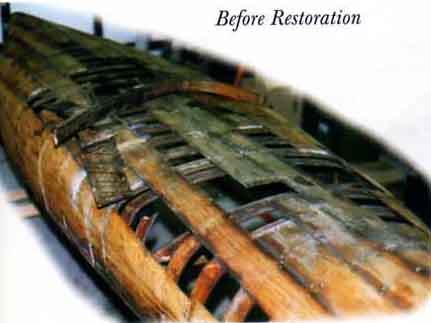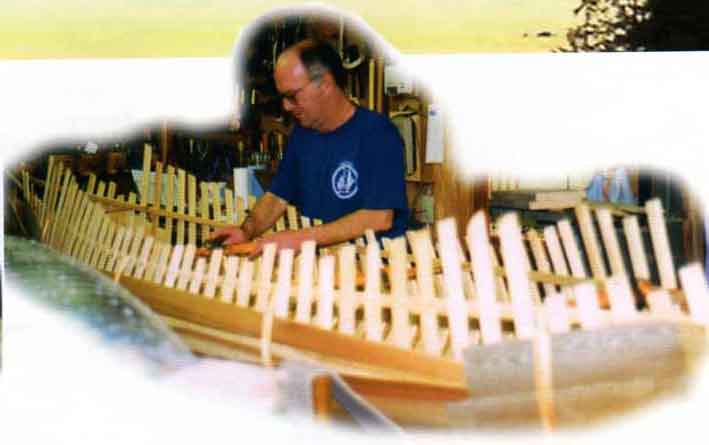

 |
 |
Doug Farr grew up around water. His family had a cottage on Rice Lake and that's where his love of canoes began. In 1984, he and his wife purchased a lot on Front Street in Bobcaygeon and spent 7 or 8 years clearing and building their retirement home.
At age 53, Doug retired and took a canoe building and repairing course and delved into doing something he found really enjoying. “I wanted something to keep my mind active and would also be something I like doing” says Doug.
One of the first big canoe restoration projects to come Doug's way was a 14 foot Chestnut Canoe, Prospector model. Although the canoe was spotted in someone's backyard with a pile of dirt beside it, it was rescued by Roger MacGregor, now author of a book called, When The Chestnut Was In Flower. Destined to become a flowerbed, the canoe was rescued and swapped for an old dory.
Chestnut canoes, crafted in New Brunswick in the early 19000's, cam with floatation devices called sponsons. Although Doug had never seen these before, and had never seen a canoe in such rough shape, he eventually agreed to take on the job and bring the canoe back to its original condition. “I knew there wasn't anything wrong that I couldn't repair,” says Doug. Although it took months, and the owner decided not to put the sponsons back on, Doug completed the job and owner used the Chestnut to canoe the New Brunswick rivers that he had canoed with his dad years before. Another customer brought in his wife's grandfather's Peterborough canoe. The husband asked Doug to restore it and put as a surprise for his wife, the words: 'In Memory of...(the grandfather)' on it. “When the wife saw it, it was an emotional moment, very touching,' says Doug. “It's those stories,” he adds, “that are the real reward.”
“Chestnut and Peterborough are the Cadillac of canoes,” explains Doug, adding that, “wooden canoes are something of a rarity now.” Many of the canoes brought to him are from the 1920s, '30s, and '40s, when canoeing was a very popular activity. Canoes have come to him from Sudbury, Quebec and the United States. Most times the repairs are to replace canvas, broken ribbing or tips rotted from resting on the ground. Doug has even developed his own filler for the canvas, because as he says, “you want the canvas to last.” Still, he advises that the life of a canoe depends entirely on how it is cared for. “A canoe stored outside won't last near as long it it's not covered with a good waterproof tarp”

Below is an interview from the Bobcaygeon Promoter by Rose Anne Kulmala
which gives you some idea how I started repairing & restoring old wood canoes.
Bobcaygeon resident Doug Farr has been the saviour of many canoes. Canoe's can, I suppose be classed as a chalice of Canadian and American history, our explorers carried and paddled them from one coast to another across this continent and our hunters and trappers made their living with them. Our North American natives were responsible for the design and manufacture of this original conveyance which could be put together in the wilds when necessary.
Many families treasure their old “family canoe”, you know, the one that's been strung up in the old boat house for years. Though it's no longer in use many folks just can't part with it.
Doug Farr came across his first canoe in a marsh off the end of Rice Lake somewhere, when he was just a kid. What a find, full of leaks and needed a lot of help...but what a find. Somehow he towed it home and started his first restoration. He learned many lessons about canoes during the primitvie restoration and he also learned how to paddle and guide the canoe noiselessly across the lake. He even built a sail for it and figured out a balancing act that enable him to sail at a fair speed. He had a lot of enjoyment and training out of that old canoe.
His second experience with canoe's was when he found an 18' freighter canoe. He spent a lot of time on that relationship. He says his greatest treasure in life has been being close to the water and these two canoes.
When he finished school he signed up in the army for three years. He was home on a leave when a fellow pulled a brand new 16' cedar canvas canoe up on the shore beside him. Doug had to have that canoe. He bought it right there, for cash with his army pay. It cost him $100. Today, a cedar canvas canoe is worth about $3,000. and Doug says the worst mistake he ever made was selling that canoe. But...he was a young father, busy with his job and his family and he could use the money...so he let it go. Years later he spent considerable time trying to track it down and buy it back. He tracked it as far as Yellowknife where the trail went cold and he had to give up.
As you can imagine having a love like this for canoes and the restoration of them has led Doug on to helping others bring their family treasure back to life. He has restored several for friends and he just can't say no when a real old beauty shows up that needs help.
Fourteen years ago Doug and his wife moved to Bobcaygeon. and built their dream retirement home. He now spends his time turning those dusty old pieces of wood and canvas back into a valued piece of family history.
If you have an old canoe stored away somewhere and need to talk to Doug, you can reach him at 705-738-5648.